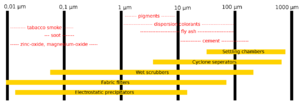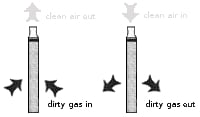
Gas filtering refers to the separating of particles from a gas - e.g. from air, or removing particulate pollution from a gaseous waste. It may also be needed to maintain indoor air quality in some cases - e.g. filtering the outlet from vacuum cleaners.
Methods
Several methods are available to filter particles from a gas. These include:
- Baffle chambers
- Settling chambers
- Cyclone separators
- Wet scrubbers
- Fabric filters
- Electrostatic precipitators
The exact type of method used will vary depending on the context. The choice of taking one particular type of filter will be determined based on the type of application, ie:
- does the filter need to be portable ?
- how well does the gas needs to be filtered/how large are the (airborne) particles in the gas ?
Depending on the amount of filtration necessary, a filter can be chosen from the schematic above.
Also take into account that several filters can be combined, so as to reduce the cost of the filtration and/or to make the filtration more economical (most filters can be cleaned others can't; ie fabric filters). This is mostly useful if very fine filtration is necessary, coarser filtration can suffice with 1 type of filter.
Another thing to take into account is what will be done with the residue after filtering. Ie fabric filters can't be cleaned and thus, the filter and all will (depending on the filth collected and the filter material itself) need to be either burned, composted, ... Filters that use a liquid (generally water) can use the residue + liquid e.g. as compost tea, or may need to be discarded another way.
Making of fabric filters

Although fabric filters can filter very finely, it should be noted that depending on the type of fabric used, as well as the weaving (or other) technique used, the final filter coarseness will vary. This also means that if the weaving is not up to standards, a fabric filter may not work at all, so careful product inspection, and solid production techniques are necessary.
Alternatives
There are also many types of plants that can be used indoors to improve air quality.W[1][2][3]
Notes and references
See also
- Liquid filter